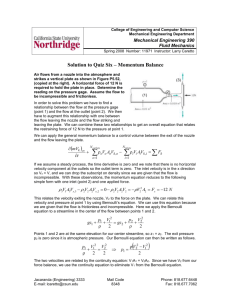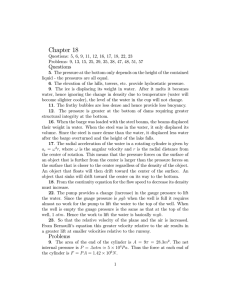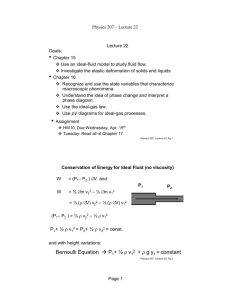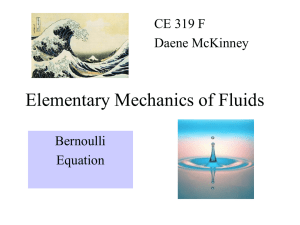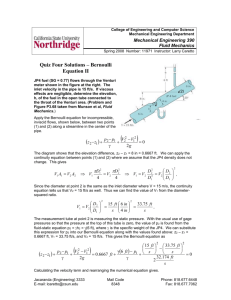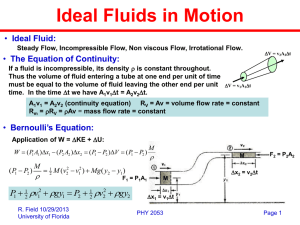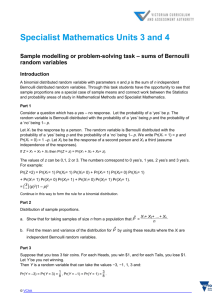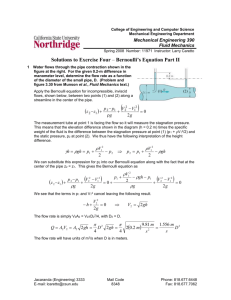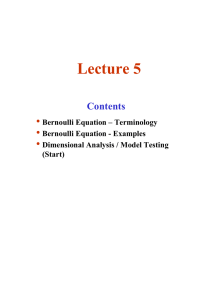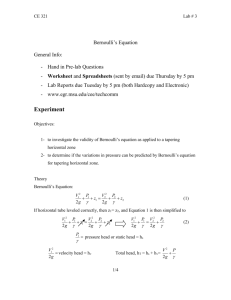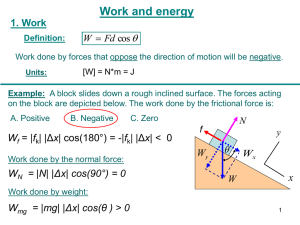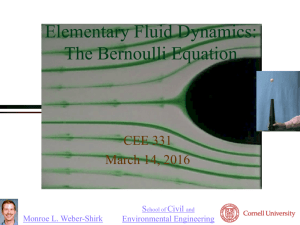Unit 3: February 14
advertisement
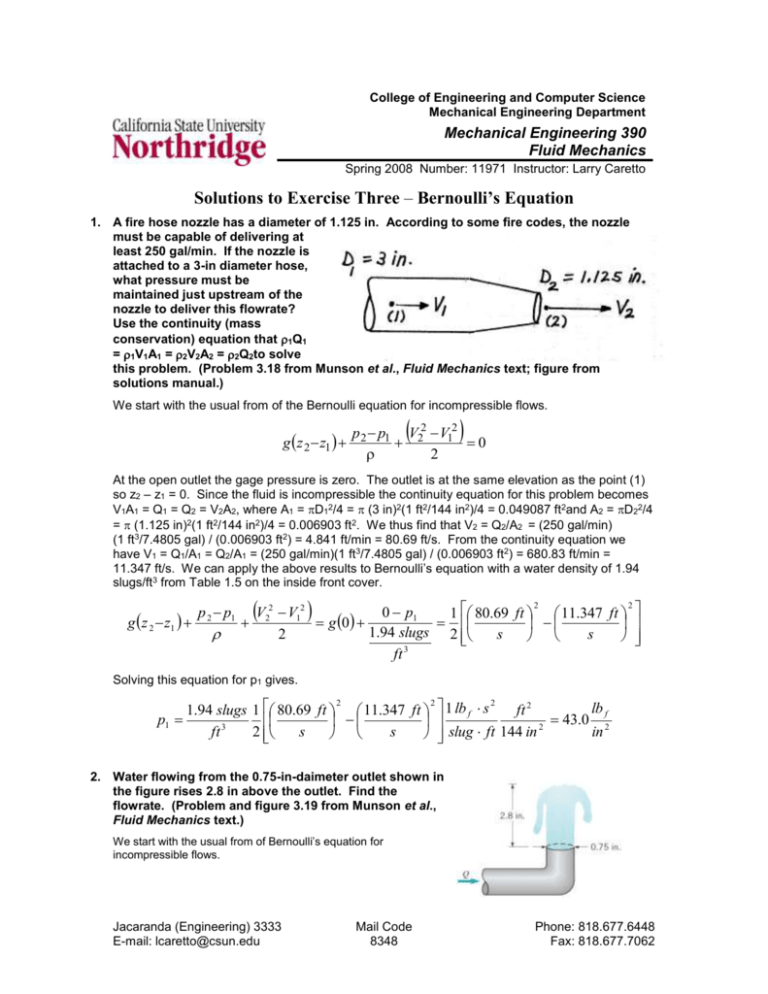
College of Engineering and Computer Science Mechanical Engineering Department Mechanical Engineering 390 Fluid Mechanics Spring 2008 Number: 11971 Instructor: Larry Caretto Solutions to Exercise Three – Bernoulli’s Equation 1. A fire hose nozzle has a diameter of 1.125 in. According to some fire codes, the nozzle must be capable of delivering at least 250 gal/min. If the nozzle is attached to a 3-in diameter hose, what pressure must be maintained just upstream of the nozzle to deliver this flowrate? Use the continuity (mass conservation) equation that 1Q1 = 1V1A1 =2V2A2 = 2Q2to solve this problem. (Problem 3.18 from Munson et al., Fluid Mechanics text; figure from solutions manual.) We start with the usual from of the Bernoulli equation for incompressible flows. p 2 p1 V22 V12 g z 2 z1 0 2 At the open outlet the gage pressure is zero. The outlet is at the same elevation as the point (1) so z2 – z1 = 0. Since the fluid is incompressible the continuity equation for this problem becomes V1A1 = Q1 = Q2 = V2A2, where A1 = D12/4 = (3 in)2(1 ft2/144 in2)/4 = 0.049087 ft2and A2 = D22/4 = (1.125 in)2(1 ft2/144 in2)/4 = 0.006903 ft2. We thus find that V2 = Q2/A2 = (250 gal/min) (1 ft3/7.4805 gal) / (0.006903 ft2) = 4.841 ft/min = 80.69 ft/s. From the continuity equation we have V1 = Q1/A1 = Q2/A1 = (250 gal/min)(1 ft3/7.4805 gal) / (0.006903 ft2) = 680.83 ft/min = 11.347 ft/s. We can apply the above results to Bernoulli’s equation with a water density of 1.94 slugs/ft3 from Table 1.5 on the inside front cover. g z 2 z1 p 2 p1 V 2 2 2 2 V12 0 p1 1 80.69 ft 11.347 ft g 0 1.94 slugs 2 2 s s 3 ft Solving this equation for p1 gives. 2 2 2 lb f 1.94 slugs 1 80.69 ft 11.347 ft 1 lb f s ft 2 p1 43.0 2 3 2 2 s s ft in slug ft 144 in 2. Water flowing from the 0.75-in-daimeter outlet shown in the figure rises 2.8 in above the outlet. Find the flowrate. (Problem and figure 3.19 from Munson et al., Fluid Mechanics text.) We start with the usual from of Bernoulli’s equation for incompressible flows. Jacaranda (Engineering) 3333 E-mail: lcaretto@csun.edu Mail Code 8348 Phone: 818.677.6448 Fax: 818.677.7062 Exercise three solutions ME 390, L. S. Caretto, Spring 2008 g z 2 z1 Page 2 p 2 p1 V22 V12 0 2 Here we apply the equation between the exit of the pipe (1) and the top of the water (2). Both locations are open to the atmosphere so we have p1 = p2 = 0. The elevation difference, z2 – z1 = 2.8 in = 0.2333 ft. At the top the velocity, V2, is zero. Setting these values into the Bernoulli equation gives. g z 2 z1 V p 2 p1 2 2 V12 V12 32..174 ft 0.2333 ft 0 0 2 2 s2 Solving for V1 gives the velocity at point 1 as follows. V1 2 32..174 ft 0.2333 ft 3.875 ft 2 s s We can find the flow rate at point 1 from the equation that Q1 = A1V1.. Q1 V1 A1 V1 3 3.875 ft 0.75 in ft 2 0.119 ft 3 4 s 4 s 144 in 2 D12 2 Several holes are punched into a tin can as shown in the figure on the right. Which of the figures represents the variation of water velocity as it leaves the holes? Justify your choice. (Problem and figure 3.17 from Munson et al., Fluid Mechanics text.) The usual from of the Bernoulli equation for incompressible flows is shown below. p 2 p1 V22 V12 g z 2 z1 0 2 For this problem, both the upper surface of the liquid and the fluid flowing out of the can are atmospheric pressure so p1 = p2. The resulting equation for the exit velocity V2 as a function of elevation, z2 is shown below. V22 V12 2 gz1 2 gz 2 V2 V 2 1 2g z 2 gz1 1/ 2 2 a bz12/ 2 Since b = (2g)1/2 is positive, this equation tells us that V2 increases as z2 decreases, varying as the square root of z2,. (Recall that z2 is the elevation so as the depth from the top of the liquid increases, the value of z2 decreases.) All curves show an increase in V2 as z2 increases, but we can immediately rule out the linear (straight line) curve in (b), because the equation that V2 a z21/2 is non-linear. This leaves the choice between (a) and (c). We see that the slope, dV/dz, in (a) increases in magnitude as z decreases while the slope in (c) decreases in magnitude as z decreases. The slope of our equation for V2 is dV2/dz2 = –b/(2z21/2). This slope is negative for any value of z2; the negative slope tells us that dV2/dz2 increases as z2 decreases. This result is consistent with the curve in figure (a).
